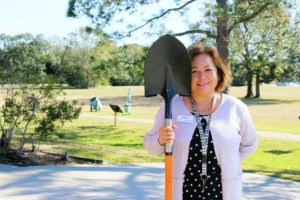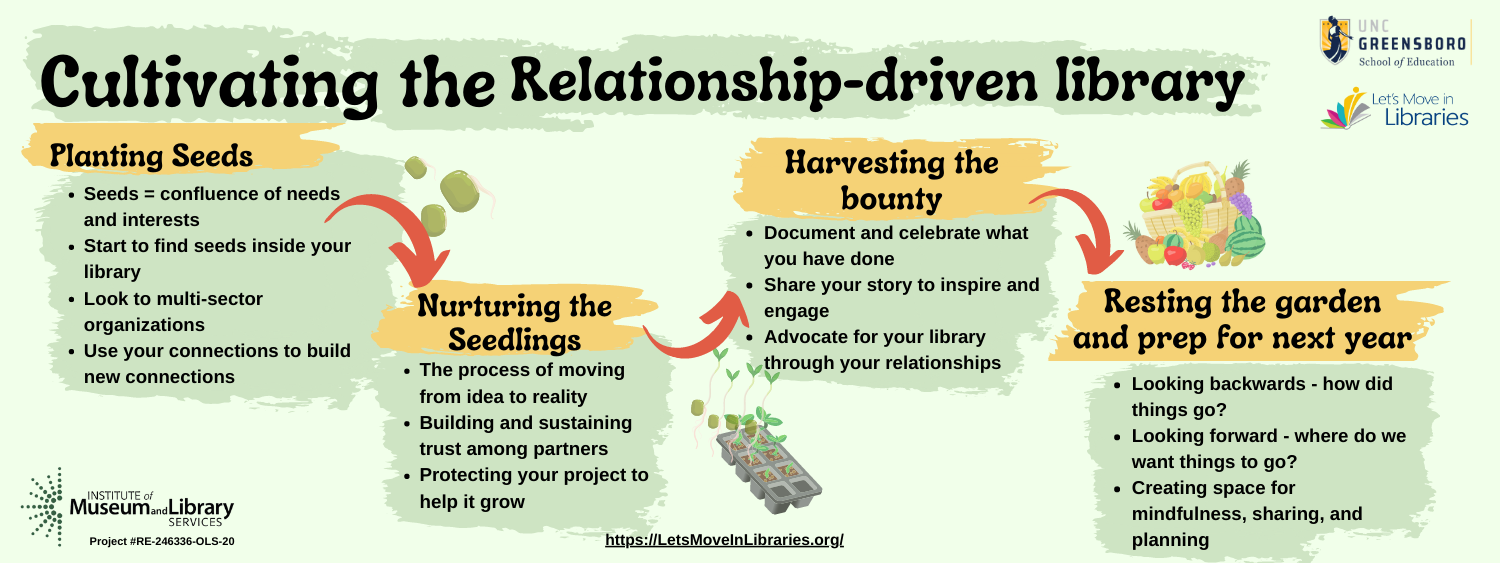Toolkit introduction:
Prepping the soil
Prepping the soil
Why should you be a gardener of community relationships and partnerships? You may be saying “I have enough on my plate just keeping the lights on and the doors open.”
This page introduces the “why” behind this work.
To get this work of building and maintaining community partnerships going you need to convince administrators, funders, and possibly even yourself that it is worth the time to do this work. That the bounty you’ll cultivate is worth the investment.
The most important work associated with prepping this soil is to get ready to talk about the importance of this work.
We have developed the following two images to illustrate what librarians often feel like they have to ask themselves before launching a new initiative, and also what partners often ask of librarians when they ask librarians for help.
![]()
We believe that changing the conversation around these topics is critical to preparing the soil for the relationship-driven library.

Given that public library workers so often feel they have to develop new initiatives by themselves, and so often are asked by external organizations to do something for them, we think it is critical to take time to celebrate and make visible the work that library workers do. We also think it is critical to take time to rest, reflect, and plan.
This is what gardeners and farmers do. Just as we know it is critically important to allow the soil to rest between growing seasons, so too we know it is critical to allow ourselves to rest in between innovation cycles.
Step 4 of our toolkit focuses on this part of the growing cycle.
Why a garden?
Why not cooking with recipes?
Why this difference matters.
Why not cooking with recipes?
Why this difference matters.
In discussing innovation in public librarianship we often get asked for recipes – step-by-step instructions that librarians can follow to create programs.
But the problem with a “recipe” is that it implies one person is doing the cooking. We’ve all heard the phrase ‘too many cooks in the kitchen.’

Gardening does not have recipes. There are too many externalities: You can plan but ultimately things are out of the control of one person. As in gardening, when we work collaboratively with communities. There is no guarantee of success – but we won’t succeed if we don’t take the risk.
This, our research tells us, is how innovation in public librarianship actually looks. The work looks less like a cook and more like a gardener: In the garden there are no guarantees of success, there are countless things you can’t control, and you always have to work in collaboration with your environment. Similarly, at the library there is no guarantee of success when you start working collaboratively with communities, there are countless things you can’t control, and you always have to work in collaboration with your environment.
Gardening also resonates because it implies there is a time and place for different things. In a kitchen, with a recipe, you can create the same dish if you have the same ingredients and supplies. That’s not true for gardening. We encourage you to lean in to the idea that you’re not in control, that you can’t do it alone, and that it’s a marathon not a sprint.
This toolkit is premised on the idea the recipes don’t work for the things that matter most in public libraries. What matters is finding the confluence of need and interest (what we call a “seed”) and then nurturing that seed/seedling in collaboration with your community so that it becomes something awesome that you all can celebrate together. This harvest celebration is in turn followed by a period of debrief (looking back) and also planning (looking forward) to next year’s gardening cycle.
We’d love to know your “why.” Let us know and we’ll add your voice to this document!
![]()



Who is this toolkit for?
This toolkit is designed to help librarians and others interested in working together to transform communities figure out:
-
- What seeds (or ideas) make the most sense for your library and for your community
- How to most effectively nurture these ideas through your expanding web of community relationships and partnerships
- How to harvest your bounty by celebrating, documenting, and sharing the results of your efforts to cultivate the relationship-driven library
- How to put your garden to rest by looking back at your journey, while also planning for next year through conversations with partners
In the image above a staff member of the Onslow County Public Library in North Carolina preps the soil for their garden.
The Milagros Tanega story
 We believe in the power of storytelling. To introduce our model we want to share one of the stories we collected that succinctly puts all the pieces together. This is Milagros Tanega, branch manager of the Evelyn Meador Library, Harris County Public Library. Her story illustrates one of the central findings of this project – namely that innovation comes from library workers/leaders and community partners coming together to work together. This finding is illustrated below Milagros’s story in two images that you are free to use however you want.
We believe in the power of storytelling. To introduce our model we want to share one of the stories we collected that succinctly puts all the pieces together. This is Milagros Tanega, branch manager of the Evelyn Meador Library, Harris County Public Library. Her story illustrates one of the central findings of this project – namely that innovation comes from library workers/leaders and community partners coming together to work together. This finding is illustrated below Milagros’s story in two images that you are free to use however you want.
When she moved to Texas she wanted to bring new ideas about sustainability to her library. She thought that the library’s greenspace would be ideal for hosting a community garden. She also knew that such an initiative is not something she could do on her own.
She “planted the seed” by telling the community she wanted to be part of efforts to support sustainability in her community and specifically that she’d love to bring a community garden to her library.
Through the simple act of sharing her idea, Milagros got connected to the collaborators she needed to get the idea off the ground. At a Rotary meeting, Milagros shared her garden idea and in the audience with the City Manager.
Shortly thereafter, the city manager was approached by a non-profit interested in started a community garden. The city manager connected the non-profit with Milagros and they started work together.
Milagros then “nurtured the seedlings” by setting up a structure to move the idea towards reality. Library staff met regularly with the non-profit to go over all the details and logistics involved with starting a community garden, developed a business plan, and successfully applied for a small grant. As a county employee, Milagros navigated a lot of legal requirements while the non-profit took lead on the actual installation work. They started small with an herb garden so they wouldn’t get too overwhelmed with the work. With that success in hand, they expanded to a raised bed garden. And with that success in hand, they expanded to a fruit forest. And they didn’t stop there. They now have a lending library of garden supplies and even a StoryWalk (pictured here), along the way expanding their web of partnerships to include schools and many more
The expansion of the effort over time is a product of how Milagros and her partners “harvested their bounty.” They created videos and shared updates on the Friends of the Library webpage, got the attention of local media, and took full advantage of social media.
The same channels that Milagros used to plant the seed of the community garden she know used to harvest, or celebrate, her bounty.
Throughout the course of this saga, Milagros took time to “rest the garden and prepare” for next steps. It’s a marathon, not a sprint. They didn’t start expanding until they got a grant, and through the structure of their regular meetings Milagros and her non-profit partner created space to debrief, share, and take stock of where they were and where they wanted to get to.



